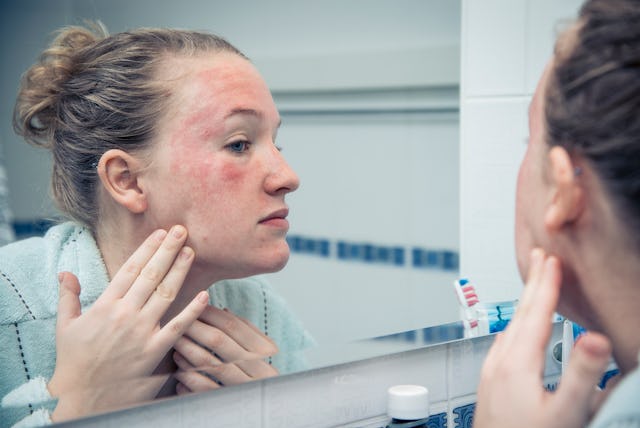How To Tell If Something In Your Skincare Routine Is Suddenly Causing You To Break The Eff Out
That "clean," "natural," "hypoallergenic" product could be causing your skin to go berserk — here's what to do.

Unless you're super into beauty and skincare, you probably don't give too much thought to the products in your routine. Who among us always has enough time to think about it beyond getting some soap in the important spots and slapping on some moisturizer?
If you've noticed some weird skin stuff — maybe some unexplained itching or tight and dry skin even when it's warm and humid out — you might not realize it could be an allergy to the skincare/beauty products you've been using for years. Yep, you can use something regularly and suddenly find yourself allergic to it. It's a cruel twist of fate that can cause a host of bizarre symptoms you would never think to link to your trusty bar of soap.
Here's how to know you're dealing with a contact allergy and what to do, straight from a dermatologist and an allergist.
Rashes and blisters and oozing, oh my!
You already know the telltale signs of an allergic reaction: an itchy, red, angry rash that can blister, swell, ooze, crack, or crust, depending on how severe the allergy is. Lovely, right? But there are two types of contact dermatitis — irritant and allergic — and the latter might cause you mysterious, head- (and full-body) scratching symptoms.
According to the Mayo Clinic, the most common type is irritant contact dermatitis. This nonallergic skin reaction occurs when an irritant (typically a chemical, like bleach or detergent) damages your skin's outer protective layer. You'll develop a reaction soon after coming into contact with the irritant.
Allergic contact dermatitis is a trickier beast, as the allergy or sensitivity tends to build up after repeated exposure, making it tough to pinpoint precisely what is causing the issue. Grab your nearest hand sanitizer or bottle of lotion and check out the ingredients list. Would you be able to tell exactly what you might be allergic to among dozens of science-y chemical names? Exactly.
What should you look for?
"Contact allergies can manifest within days — once you have a second exposure to the product at least — but they can also appear months or years later if you eventually become sensitized to a product or ingredient," explains Dr. Geeta Yadav, board-certified dermatologist and founder of FACET Dermatology. And the reaction might not stay localized to where the product is applied, so you might notice full-body itching days or weeks after using nail polish, having your hair dyed, or trying a new beauty or skincare product, adds Kathleen Dass, MD, an immunologist at the Michigan Allergy, Asthma & Immunology Center.
Aside from your super obvious rash symptoms, both doctors note that contact dermatitis can manifest in a number of uncomfortable and downright painful ways. You might also experience:
- Skin that feels tight, dry, or uncomfortable
- Hyperpigmentation and/or discoloration of the skin
- Acne
- Skin flushing
- Signs of infection (such as green or yellow pus)
- Irritability/mood changes and behavioral issues
"A more serious and unexpected reaction would be a widespread rash or itching that prevents you from being able to sleep or go about your day," says Yadav. "Sometimes the rest of the body can react in sympathy to the contact allergy by developing eczema elsewhere." Unexplained symptoms could absolutely impact both your physical and mental health, something this very writer knows all too well.
Another annoying factor: Anyone can develop a contact allergy at any time to just about anything, which means there's often not much rhyme or reason to the 'how' and 'why.'
So, what should you do?
"Contact allergies can sometimes be difficult to diagnose if the dermatitis is occurring in a location where you don't remember having direct contact," says Dass. "Often, we use so many different formulas in our routines that it can be difficult to determine which one caused a reaction. It's pretty clear when you react to a specific product you've just started using, but if you develop an intolerance to something that's existed in your regimen for some time, it becomes a challenge," adds Yadav.
Visiting an allergy specialist is your best bet, as patch testing will help determine which agents are causing the reaction. Patch testing involves a doctor placing common allergens on your skin for two or three days before a return visit to see the results. It can be a long-term process of elimination to figure out what's causing your contact allergies, whether it be the gold and nickel on your clothing and jewelry or the products you've been using daily without prior issue.
From extensive personal experience, I can say that buzzwords on packaging — "clean," "natural," "organic," and even "hypoallergenic" — don't mean much if a product is causing a contact allergy. "Products that you feel like can help the skin can also sometimes hurt it," says Dass. "Neosporin is the third common contact allergen, but people may be applying it to their rash to make it better without realizing. Lanolin is another common allergen found in many lotions, like Aveeno. Someone may be applying Aveeno lotion to their skin, but potentially making their rash worse."
A crucial first step is finding an allergist who can help you navigate the situation. Even if you are only mildly bothered by a skin issue, it's worth having a patch test just to help yourself feel better and find products that won't make your skin freak the eff out.
This article was originally published on